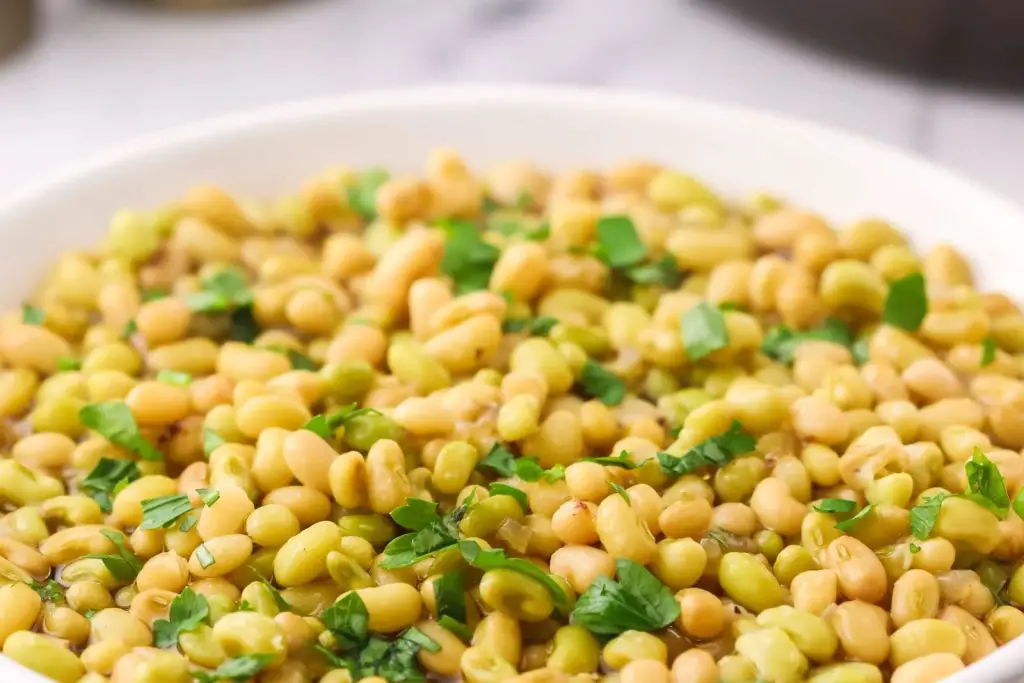
Scarlet runner beans (Phaseolus Coccineus) are a delightful addition to any garden, admired for their vibrant flowers and flavorful beans. Freezing these beans is a fantastic way to prolong their enjoyment beyond their growing season. By following a simple freezing process, you can ensure that your scarlet runner beans retain their taste, texture, and nutritional value. This guide will walk you through the steps of freezing scarlet runner beans, allowing you to savor their goodness throughout the year.
Here’s a step-by-step guide on how to freeze scarlet runner beans:
Step 1: Select fresh scarlet runner beans
When embarking on the process of freezing scarlet runner beans, the initial step is crucial in determining the quality and taste of the preserved beans. Opting for beans that are young, tender, and devoid of any blemishes is of utmost importance. Here’s why this selection process matters:
- Young and Tender: Young scarlet runner beans are at their prime in terms of flavor, texture, and nutritional content. These beans are more succulent and have a pleasantly crisp texture, making them a delightful addition to future dishes even after freezing. Their tenderness ensures that they retain a pleasing bite after being cooked.
- Flavor Preservation: Scarlet runner beans that are harvested at their peak freshness possess a vibrant and robust flavor profile. By selecting beans at this stage, you are setting the foundation for maintaining the distinct taste of the beans throughout the freezing and thawing process. This ensures that the scarlet runner beans you enjoy months later will still be packed with the same rich and satisfying flavors.
- Texture Retention: The choice of young and tender scarlet runner beans plays a key role in retaining their texture after freezing. These beans have a firmer outer layer and a tender interior, which helps them withstand the freezing process without becoming mushy. The result is frozen beans that can be cooked to perfection, providing a satisfying mouthfeel in your dishes.
- Blemish-Free Quality: Beans that are free from blemishes, spots, or signs of damage are less likely to deteriorate during freezing. Blemishes can indicate the presence of spoilage or decreased freshness, which can negatively affect the overall quality of the frozen beans. Opting for scarlet runner beans in impeccable condition ensures that you’re starting with the best possible product.
Step 2: Wash and trim the beans
Ensuring the cleanliness and optimal preparation of scarlet runner beans before freezing is a vital step in maintaining their quality during storage. Washing and trimming the beans not only removes potential contaminants but also enhances their visual appeal and overall taste. Here’s a closer look at why this step is crucial:
- Thorough Cleaning: Washing scarlet runner beans under cool running water helps remove dirt, dust, and any residual pesticides or chemicals that might be present on the surface. This step is essential to ensure that the beans you freeze are free from any unwanted substances that could compromise their safety and flavor.
- Quality Assurance: Cleaning the beans offers an opportunity to inspect them closely. This allows you to identify and discard any beans that might have imperfections, such as bruising, spotting, or damage. By eliminating these subpar beans, you’re ensuring that only the best specimens make their way into your freezer.
- Trimming for Optimal Storage: Trimming the ends of the scarlet runner beans serves multiple purposes. Firstly, it removes any dry or woody parts that could impact the overall texture of the beans once they are cooked. Secondly, it prepares the beans for even cooking during meal preparation. Removing any tough or stringy parts guarantees that the frozen beans will be as enjoyable to eat as their fresh counterparts.
- Aesthetic Appeal: Properly trimmed and cleaned scarlet runner beans are not only more visually appealing but also more appetizing. When you eventually use these beans in your culinary creations, their pristine appearance will contribute to the overall presentation of your dishes.
Is it possible to freeze scarlet runner beans in their pods?
While possible, freezing scarlet runner beans in their pods is less common due to potential texture issues. Pods may become tough and fibrous upon thawing and cooking. It’s recommended to shell the beans before freezing for better quality and uniform freezing.
Step 3: Blanch the scarlet runner beans
Blanching is a crucial step in the process of freezing scarlet runner beans, offering a range of benefits that contribute to their overall quality and longevity in storage. This technique involves a brief exposure to boiling water followed by rapid cooling, and it plays a pivotal role in preserving the beans’ color, flavor, and texture. Let’s delve into the significance of blanching in the context of freezing scarlet runner beans:
- Color Retention: Scarlet runner beans are known for their vibrant and appealing color. However, this color can fade over time, especially during freezing. Blanching helps to counteract this color loss by deactivating enzymes responsible for breaking down pigments. This means that blanched beans will maintain their attractive color even after months in the freezer.
- Flavor Preservation: The natural sugars and flavors within scarlet runner beans can degrade during freezing. By blanching the beans, you halt enzymatic activity that can lead to flavor deterioration. This ensures that when you eventually use the frozen beans in your cooking, they will deliver the same delightful taste as if they were freshly harvested.
- Texture Maintenance: Freezing can sometimes cause the cell walls of vegetables to break down, resulting in a mushy or undesirable texture. Blanching, followed by rapid cooling in ice water, helps to set the beans’ texture, preserving their crispness and bite. The quick temperature change during blanching limits the development of large ice crystals that could damage the cell structure of the beans.
- Enzyme Inactivation: The enzymes present in scarlet runner beans continue to be active even after harvesting. These enzymes can lead to changes in color, flavor, and texture over time. Blanching effectively deactivates these enzymes, extending the shelf life of the frozen beans and maintaining their overall quality.
- Blanching Process: The blanching process involves submerging the scarlet runner beans in boiling water for a brief period (usually 2-3 minutes). The beans are then rapidly cooled in ice water to halt the cooking process. This step-by-step process ensures that the beans are cooked just enough to achieve the desired preservation effects without fully cooking them.
Can I freeze scarlet runner beans without blanching them?
Freezing scarlet runner beans without blanching can result in compromised color, flavor, and texture. Blanching, a brief boiling and cooling process, inactivates enzymes that can cause quality degradation during freezing. It is advisable to blanch beans before freezing to ensure optimal frozen quality.
Step 4: Drain and dry the beans
After blanching and cooling scarlet runner beans, the next step in the freezing process involves draining and drying them thoroughly. This seemingly simple step holds significance in maintaining the beans’ quality during freezing and storage. Let’s explore why draining and drying the beans is essential:
- Removing Excess Moisture: During the blanching process, scarlet runner beans absorb some water. Draining the beans ensures that any excess moisture is removed. Excess moisture can lead to ice crystals forming on the beans’ surface during freezing, which can negatively affect their texture and flavor. By draining the beans, you’re reducing the risk of freezer burn and maintaining the beans’ overall quality.
- Texture Preservation: Properly draining the scarlet runner beans helps preserve their texture. Excess moisture can cause the beans to become mushy or lose their characteristic snap when cooked. Drying them ensures that the beans maintain their integrity, resulting in a more pleasing texture when used in future dishes.
- Minimizing Ice Crystal Formation: When scarlet runner beans are frozen, any remaining water on their surface can turn into ice crystals. These ice crystals can puncture the cell walls of the beans, leading to a change in texture. By patting the beans dry with a clean kitchen towel, you’re minimizing the amount of water present on the beans, which in turn reduces the formation of ice crystals.
- Preventing Clumping: Beans that are frozen with excess moisture can stick together, forming clumps that are difficult to separate when you want to use them. By ensuring that the beans are properly dried before freezing, you’re preventing them from sticking together, making it easier to portion them out when needed.
- Cleanliness and Hygiene: Drying the scarlet runner beans after blanching also contributes to cleanliness and hygiene. Excess moisture can promote the growth of microorganisms during freezing, potentially compromising the safety and quality of the frozen beans. Drying them helps maintain a sanitary environment for storage.
Step 5: Arrange the beans and flash-freeze
After preparing the scarlet runner beans by blanching, draining, and drying, the next step involves arranging them on a baking sheet and subjecting them to a process called flash-freezing. This technique is essential for maintaining the quality and convenience of the beans during freezing and storage. Let’s delve into the significance of arranging the beans and employing the flash-freezing method:
- Preventing Clumping: Placing the blanched and dried scarlet runner beans in a single layer on a baking sheet is a strategic move to prevent them from sticking together as they freeze. This arrangement minimizes the likelihood of the beans forming a solid clump, which can make portioning and using them in cooking a challenging task.
- Individual Freezing: Flash-freezing ensures that each scarlet runner bean freezes individually and maintains its distinctness. Individual freezing is crucial because it allows you to easily retrieve the desired amount of beans from the freezer without having to defrost a larger clump.
- Quick Freezing: The flash-freezing process involves placing the baking sheet with the beans directly in the freezer. This rapid freezing method ensures that the beans freeze quickly and efficiently. Quick freezing is important for preserving the beans’ texture and flavor by minimizing the formation of large ice crystals that can compromise the beans’ cellular structure.
- Maintaining Quality: When scarlet runner beans freeze individually and rapidly, the quality of the beans is better preserved. Flash-freezing locks in the beans’ color, flavor, and texture, resulting in frozen beans that closely resemble their fresh counterparts when cooked.
- Preventing Freezer Burn: By ensuring that the beans freeze quickly and individually, you’re reducing the risk of freezer burn. Freezer burn occurs when moisture on the surface of food turns into ice crystals, leading to texture changes and flavor degradation. Flash-freezing helps mitigate this risk.
- Ease of Portioning: Once the scarlet runner beans are flash-frozen on the baking sheet, they can be conveniently transferred to a freezer-safe container or bag. Because the beans are not clumped together, you can easily take out just the amount you need without defrosting the entire batch.
Step 6: Package and seal the scarlet runner beans
As you progress in the freezing process of scarlet runner beans, packaging and sealing the beans appropriately becomes a crucial step in ensuring their long-term quality and protection from freezer-related issues. Here’s why carefully packaging and sealing the beans is essential:
- Preservation of Freshness: Transferring the frozen scarlet runner beans into airtight freezer-safe bags or containers helps seal in their freshness. Airtight packaging prevents the beans from being exposed to air and moisture, which can lead to freezer burn and deterioration of flavor and texture.
- Prevention of Freezer Burn: Freezer burn occurs when moisture on the surface of food forms ice crystals and then sublimates back into the air. This process can lead to dry, discolored patches on the beans and an alteration in taste and texture. By choosing airtight packaging and minimizing air within the bags or containers, you’re reducing the likelihood of freezer burn.
- Squeeze Out Excess Air: Removing excess air from the bags before sealing is a critical step in preventing freezer burn. Air contains moisture, which contributes to the development of ice crystals. By squeezing out as much air as possible, you’re creating an environment less conducive to freezer burn, ensuring that your frozen scarlet runner beans remain in top condition.
- Optimal Storage: Airtight packaging also aids in efficient storage. Bags or containers take up less space in the freezer compared to loosely packed beans, allowing you to maximize your freezer’s storage capacity.
- Convenient Portioning: Properly packaged scarlet runner beans are easier to portion when you’re ready to use them. You can take out the desired quantity without defrosting the entire batch. This convenience reduces food waste and makes meal preparation more straightforward.
- Longer Shelf Life: The combination of airtight packaging and the removal of excess air contributes to the prolonged shelf life of frozen scarlet runner beans. When sealed correctly, these beans can maintain their quality for an extended period, allowing you to enjoy their taste and nutritional benefits over time.
Step 7: Label and date the packages
After packaging and sealing your frozen scarlet runner beans, taking the time to label each package with relevant information is a small yet essential practice that offers several benefits for organized freezer management. Here’s why labeling and dating packages is crucial:
- Contents Identification: Using a permanent marker to label each package with the contents (scarlet runner beans) ensures that you can easily distinguish them from other items in your freezer. This simple act of identification saves you time and prevents confusion when you’re searching for specific ingredients.
- Storage Organization: Labeling the packages allows you to maintain a well-organized freezer. When packages are clearly labeled, you can quickly locate the scarlet runner beans you need without needing to open multiple packages or guess their contents.
- Prevention of Food Waste: Clear labeling helps prevent food waste. When you know exactly what’s in each package, you’re less likely to forget about ingredients you’ve frozen. This means you’ll be more likely to use them before they become forgotten and eventually go to waste.
- Tracking Storage Time: Adding the date of freezing to the label is crucial for tracking the storage time of the scarlet runner beans. Different foods have varying recommended storage durations in the freezer. By dating the packages, you can ensure that you use the beans within their optimal time frame for quality and safety.
- Quality Assurance: Over time, frozen foods can lose quality, including taste, texture, and nutritional value. By labeling the packages, you’ll be able to monitor how long the scarlet runner beans have been in the freezer. This awareness empowers you to prioritize using older packages first, ensuring that you always enjoy the best quality beans.
- Convenient Meal Planning: Labeled and dated packages make meal planning and preparation more convenient. You’ll have a clear record of what’s available and when it was frozen, allowing you to plan your meals based on the ingredients you have on hand.
Step 8: Store in the freezer
As you near the completion of the freezing process for scarlet runner beans, the final step involves placing the sealed packages of beans in the freezer for safekeeping. This step might seem straightforward, but it plays a critical role in maintaining the quality and safety of the frozen beans. Here’s why proper freezer storage is essential:
- Temperature Control: Storing scarlet runner bean packages in the coldest part of your freezer ensures that they remain at a consistently low temperature. A temperature of 0°F (-18°C) or lower is considered ideal for freezing food. At these temperatures, the growth of harmful microorganisms is significantly slowed down, preserving the quality and safety of the beans.
- Minimizing Freezer Burn: Freezer burn occurs when food is exposed to air and moisture within the freezer. Placing the sealed packages of scarlet runner beans in the coldest part of the freezer reduces the chances of moisture condensation on the beans’ surface, which is a primary cause of freezer burn. This step helps maintain the beans’ texture, flavor, and appearance.
- Preserving Nutritional Value: Storing frozen scarlet runner beans at the recommended temperature ensures that their nutritional value is preserved. Vitamins, minerals, and other nutrients degrade more slowly at lower temperatures, allowing you to reap the full benefits of the beans when you use them in your meals.
- Maintaining Quality: Proper freezer storage contributes to maintaining the overall quality of the scarlet runner beans. Their color, taste, and texture remain intact, allowing you to enjoy dishes that closely resemble those made with fresh beans.
- Food Safety: Freezing scarlet runner beans at the appropriate temperature helps ensure their safety for consumption. Harmful bacteria and pathogens are less likely to multiply and cause foodborne illnesses at colder temperatures, protecting you and your family from potential health risks.
- Effective Space Utilization: The coldest part of the freezer is typically where the temperature is most consistent. Placing the scarlet runner bean packages in this area helps them freeze evenly and efficiently. Additionally, it helps you optimize your freezer space by using the most suitable area for long-term storage.
How long can I store frozen scarlet runner beans?
Properly stored, frozen scarlet runner beans can maintain good quality for up to 12 months. Ensure a temperature of 0°F (-18°C) or lower in your freezer. Regularly check for freezer burn or changes in texture to ensure optimal usage.
Other related questions
How do I defrost scarlet runner beans?
To defrost scarlet runner beans, transfer the sealed package from the freezer to the refrigerator. Allow beans to thaw gradually for several hours or overnight. Alternatively, place beans in a sealed plastic bag and submerge in cold water, changing water every 30 minutes until thawed.
Can I use frozen scarlet runner beans directly in recipes without thawing?
Yes, you can use frozen scarlet runner beans directly in recipes without thawing. Adding frozen beans directly to cooked dishes during the final minutes of cooking is a convenient method. This preserves their taste and texture while simplifying meal preparation.
Can I refreeze scarlet runner beans?
It’s generally not recommended to refreeze scarlet runner beans once they’ve been thawed. Refreezing can compromise texture and quality due to moisture loss and cell damage during the thawing process. To maintain optimal taste and safety, consume thawed beans promptly after initial thawing.
How do I know if the scarlet runner beans have gone bad after being frozen?
Signs of frozen scarlet runner beans going bad include freezer burn, changes in color, texture, or appearance, off-putting odors, or ice crystals. Taste may also deteriorate. If any of these signs are evident, it’s advisable to discard the beans to ensure safety and quality of dishes prepared.
What can I do with frozen scarlet runner beans?
Frozen scarlet runner beans can be used in various dishes, including soups, stews, stir-fries, and side dishes. Blanching before freezing preserves their quality for versatile cooking applications. Simply add frozen beans directly to cooked dishes during the final minutes of preparation to enjoy their vibrant flavor and texture.
Can frozen scarlet runner beans be used in salads?
Frozen scarlet runner beans can be used in salads, but their texture might be softer due to the freezing process. Thaw them before use to avoid the icy crunch. Consider using them in salads that don’t require crispness or blanching them briefly before freezing for better salad texture.
Can I freeze scarlet runner beans with seasoning or herbs?
It’s recommended to freeze scarlet runner beans plain, without seasoning or herbs. Adding seasoning before freezing can result in flavor dilution and texture changes. For optimal taste and texture, incorporate seasoning or herbs during cooking after thawing the beans.
Can I freeze scarlet runner beans that have been previously cooked?
Yes, you can freeze scarlet runner beans that have been previously cooked. However, their texture may change during freezing and thawing. For better results, blanch raw beans before freezing instead of freezing cooked ones.








